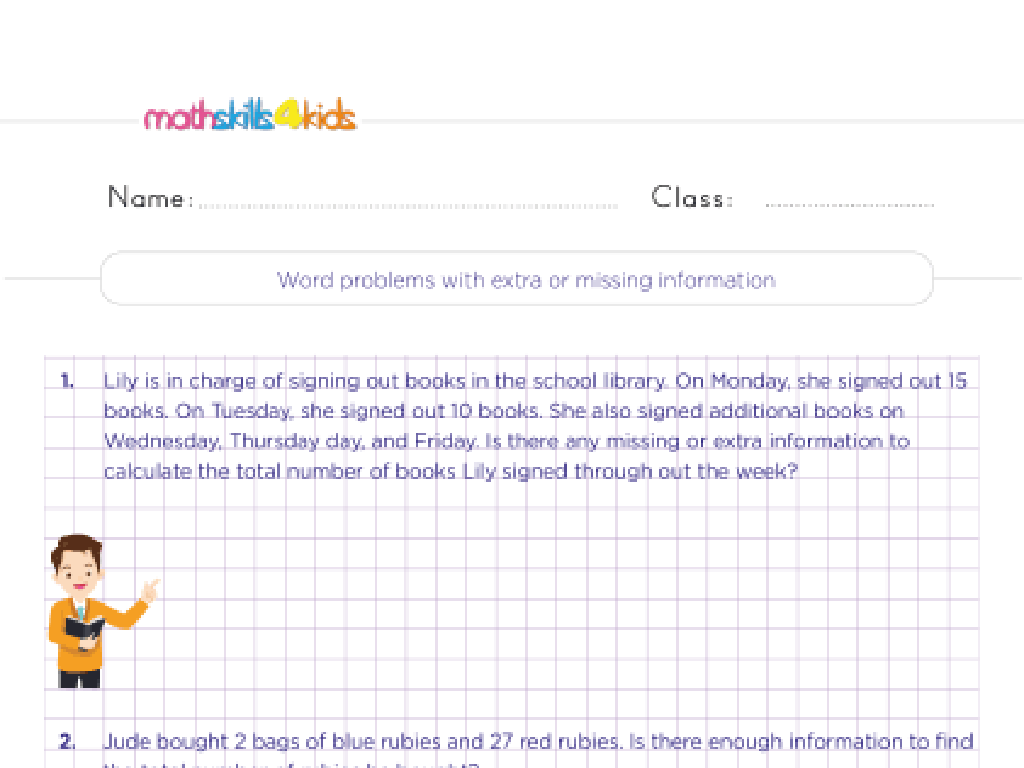Financial Goals
Subject: Life skills
Grade: High school
Topic: Financial Literacy
Please LOG IN to download the presentation. Access is available to registered users only.
View More Content
Introduction to Financial Goals
– Understanding Financial Literacy
– Financial literacy is the ability to manage money effectively.
– Defining Financial Goals
– Goals related to saving, investing, and making money.
– Importance of Financial Goals
– They guide financial decisions and help achieve stability.
– Impact on Future Success
– Setting goals can lead to long-term wealth and security.
|
This slide introduces the concept of financial goals within the broader context of financial literacy. It’s crucial for students to grasp that financial literacy is not just about saving money, but also about making informed decisions that will impact their future financial well-being. Financial goals can range from short-term objectives like saving for a new phone to long-term aspirations such as retirement savings. Emphasize the importance of setting clear, achievable goals as a roadmap to financial success. Discuss how these goals can motivate students to learn about and practice good financial habits, leading to a more secure and prosperous future.
Types of Financial Goals
– Short-term financial goals
– Saving for immediate desires, like a concert
– Mid-term financial goals
– Goals for the next few years, like buying a car
– Long-term financial goals
– Planning for significant future expenses, such as college or retirement
|
This slide categorizes financial goals into three types based on the time frame of the goal. Short-term goals usually span a period of up to a year and could include saving for a concert or a new gadget. Mid-term goals may range from one to five years and often involve larger purchases or investments, such as a car or a down payment on a house. Long-term goals extend beyond five years and are typically the most substantial, including saving for college tuition or retirement. It’s crucial to teach students the importance of setting specific, measurable, achievable, relevant, and time-bound (SMART) goals in each category to effectively manage their finances and work towards financial stability and independence.
Setting SMART Financial Goals
– Define your goal clearly
– Be precise, e.g., ‘Save $1,000 for a new laptop’
– Measure progress effectively
– Track savings monthly to reach your target
– Ensure goals are realistic
– Assess your income and expenses to set attainable goals
– Align goals with personal values
– Choose goals that matter to you, like education or travel
– Set a deadline for your goal
– Example: ‘I will save $1,000 by December 1st’
|
When teaching students about setting financial goals, emphasize the importance of the SMART criteria to ensure their goals are well-defined and achievable. Specific goals have a clear objective, making them more tangible. Measurability allows students to track their progress. Goals should be achievable; setting unrealistic goals can lead to discouragement. Relevance ensures that the goals are meaningful and motivating to the individual. Lastly, being time-bound introduces a sense of urgency and can help in planning. Encourage students to apply these principles to their own financial goals and to consider creating a simple action plan to achieve them.
Creating a Financial Plan
– Identify income and expenses
– List all sources of income and all expenses to see net flow.
– Budget for financial goals
– Allocate funds towards short-term and long-term objectives.
– Adjust plan as necessary
– Review and modify budget to stay on track with goals.
|
This slide is aimed at helping students understand the importance of creating a financial plan. Start by identifying all sources of income, such as wages, allowances, or gifts, and then list all expenses, including both fixed costs like rent and variable costs like entertainment. Next, discuss how to create a budget that aligns with their financial goals, whether they’re saving for college, a car, or simply wanting to manage their money better. Emphasize the importance of flexibility in financial planning; unexpected expenses may arise, and students should feel empowered to adjust their budgets accordingly. Encourage students to track their spending and review their budget monthly to ensure they are on track to meet their goals.
Overcoming Obstacles in Financial Goals
– Identify common financial hurdles
– Unexpected expenses, limited income
– Strategies to tackle obstacles
– Budgeting, saving plans, additional income sources
– Perseverance and flexibility
– Stay committed, adapt to changes
– Importance in goal achievement
|
This slide addresses the challenges students may face when setting and striving to achieve financial goals. Discuss common obstacles such as unexpected expenses or limited income, and explore strategies like effective budgeting, creating saving plans, and seeking additional income sources. Emphasize the importance of perseverance in sticking to financial plans and the flexibility to adapt when circumstances change. Encourage students to share their experiences or concerns regarding financial goals, and facilitate a discussion on how to apply these strategies in real-life scenarios.
Financial Goals: Tools & Resources
– Utilize finance tracking apps
– Apps like Mint or YNAB help monitor spending and budget.
– Explore educational resources
– Websites like Investopedia offer tutorials on financial concepts.
– Seek professional financial advice
– Advisors provide personalized guidance for financial planning.
– Integrate tools for success
|
This slide aims to equip students with knowledge about various tools and resources available for managing their finances effectively. Highlight the importance of using apps and websites to keep track of spending habits and create budgets. Encourage students to further their financial education through online resources that offer free tutorials and articles. Discuss the benefits of consulting with financial advisors or counselors for personalized financial planning, especially for more complex financial goals. Emphasize that integrating these tools can lead to better financial decision-making and success in achieving their financial goals.
Class Activity: Setting Personal Financial Goals
– Break into small groups
– Discuss personal financial goals
– Think about short-term and long-term objectives
– Write down your goals and plans
– Consider SMART criteria: Specific, Measurable, Achievable, Relevant, Time-bound
– Present goals to the class
|
This class activity is designed to engage students in practical financial planning. Divide the class into small groups to foster a more intimate discussion environment. Each student should reflect on their own financial aspirations, considering both short-term goals (like saving for a concert ticket) and long-term goals (like saving for college). Encourage them to apply the SMART criteria to ensure their goals are well-defined and attainable. After the discussion and writing phase, each group will present their goals to the class, which will help students articulate their plans and learn from their peers’ approaches. For the teacher: Prepare to facilitate the group discussions, provide examples of financial goals, and assist students in applying the SMART criteria. Offer feedback on their presentations to reinforce the learning objectives.






